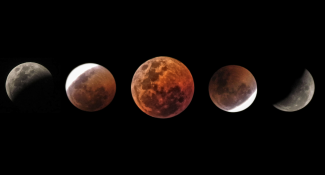When is the next lunar eclipse? When is the next solar eclipse? Get 2023 eclipse dates and times, complements of The 2023 Old Farmer’s Almanac. Also, provided are definitions of different types of eclipses.
Advertisement
There will be four eclipses in 2023, two of the Sun and two of the Moon. Solar eclipses are visible only in certain areas and require eye protection to be viewed safely. Lunar eclipses are technically visible from the entire night side of Earth, but during a penumbral eclipse, the dimming of the Moon’s illumination is slight. See below for explanations of the different types of eclipses.
Lunar Eclipses 2023
May 5, 2023: Penumbral Eclipse of the Moon. This eclipse is not visible from North America. (The eclipse is visible from the Antarctic, Oceana, Australasia, Asia, Europe, Africa, and South Georgia and the South Sandwich Islands.)
October 26, 2023: Partial Eclipse of the Moon. This eclipse is visible from northeastern North America. The Moon will rise during the eclipse and observers will only see a penumbral eclipse. The Moon will enter the penumbra at 2:00 P.M. EDT and the umbra at 4:54 P.M. EDT and the penumbra at 6:28 P.M. EDT.
See your Moon rise and set times.
Solar Eclipses 2023
April 19–20, 2023: Annular Total Eclipse of the Sun. This hybrid eclipse, which is seen as annular or total depending on view location along its path, is not visible from North America. (It is visible only from the southern Indian Ocean, parts of Antarctica, most of Australasia, Indonesia, Philippines, most of Oceana, and the western Pacific Ocean.)
October 13, 2023: Annular Eclipse of the Sun. This eclipse is at least partially visible from most of North America. The annular phase is visible in a narrow path that runs through Oregon, Nevada, Utah, Arizona, New Mexico, and Texas. The eclipse begins at 11:04 A.M. EDT (8:04 A.M. PDT) and ends at 4:55 P.M. EDT (1:55 P.M. PDT).
What is a Lunar Eclipse?
During a lunar eclipse, the Moon appears dark or dimmed. This happens because the Earth is positioned exactly between the Moon and the Sun, blocking much of the sunlight from reaching the Moon’s surface. Instead, Earth’s shadow is cast upon the Moon’s surface.
Sometimes, the Moon appears reddish-orange during an eclipse. This is because some of the light from the Sun makes it through Earth’s atmosphere. But only longer wavelengths make it; these are the red and orange colors.
A lunar eclipse only happen on the full Moon. The eclipse is technically visible from the entire night side of Earth, but during a penumbral eclipse, the dimming of the Moon’s illumination is slight.
Learn more about lunar terminology.
What is a Solar Eclipse?
During a solar eclipse, the Moon blocks the Sun from view. The Moon, Earth, and Sun are aligned with the Moon stuck in the middle. If the alignment is perfect, the Moon completely blocks our view of the Sun, casting its dark shadow on Earth. If the alignment is a little off-center, the Moon may just partially block our view of the Sun.
Though lunar eclipses and solar eclipses happen with the same frequency (about 4 to 7 times a year, in total), it’s rare to see a solar eclipse since they are only visible from a small area of Earth each time. Solar eclipses are visible only in certain areas and require eye protection to be viewed safely.
The next total solar eclipse to visit North America will be April 8, 2024. The duration of totality will be up to 4 minutes and 27 seconds! More news to come on that big event!
Types of Eclipses
Not all eclipses are the same. There are a few different ways for lunar and solar eclipses to happen:
- A total eclipse (of either the Moon or the Sun) occurs when the Moon or Sun is entirely blocked out.
- During a total lunar eclipse, the Moon is completely obscured by the dark center of Earth’s shadow (called the umbra), giving the Moon a dark, reddish hue.
- During a total solar eclipse, the Sun is completely obscured by the Moon, resulting in a brief period of awe-inspiring darkness.
- A partial eclipse (of either the Moon or the Sun) occurs when only part of the Moon or Sun is obscured.
- An annular eclipse is a type of solar eclipse. Annular eclipses are similar to total solar eclipses (where the Sun is completely obscured by the Moon), but in an annular eclipse, the Moon’s apparent size is smaller than the Sun’s, meaning that the Sun is not completely obscured. This results in a very bright ring of light called an annulus.
- A penumbral eclipse is a type of lunar eclipse. Penumbral eclipses occur when the Moon enters only the faint outer edge of Earth’s shadow (called the penumbra), which causes the Moon to appear slightly darker than usual. The effect is so slight that a penumbral eclipse can be hard to recognize unless you know to look for it!
Transit of Mercury 2023
There is also a phenomenon called a transit, which is similar to an eclipse, though not quite as visually stunning. A transit occurs when one celestial body passes between a larger celestial body and a third celestial body. For example, when Mercury passes between the Sun and the Earth, this is called a transit of Mercury. Because Earth is the third planet from the Sun, we are able to observe transits of both Mercury and Venus.
Mercury’s proximity to the Sun makes it difficult to observe (unlike other planets). In 2023, Mercury is best viewed from the Northern Hemisphere just after sunset in the second week of April and shortly before sunrise in late September. Spot Mercury close to Jupiter after sunset on March 26, 27, or 28. Look for a conjunction between Mercury and Venus on the evening of July 26; Mars will also be nearby.

Comments